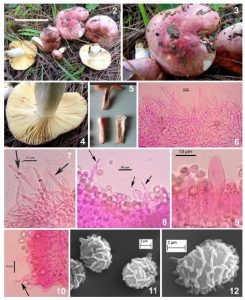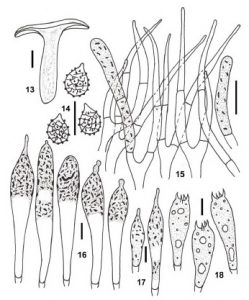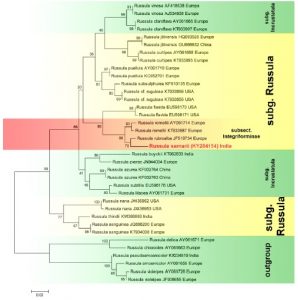Russula sarnarii A. Ghosh, K. Das & R.P. Bhatt, sp. nov., Index Fungorum number: IF 819419
Etymology: To commemorate Dr. Mauro Sarnari for his invaluable contribution to the systematics of the genus Russula.
Holotype: AG 15–755 (CAL)
Basidiomata up to 30–55 mm. in height, small to medium-sized. Pileus 20–70 mm. in diam., hemispheric when young, then convex, planoconvex, expanding to applanate with broad but slight depression above the stipe on maturity, margin entire when young, margin irregularly wavy at maturity; surface dry, smooth, pitted at some places, cracked when mature, pale red (11–12A3), pink rose (11–12A4) to pastel pink (11A4–5), marginally pinkish white (11A2–3), greyish rose (11–12B4–6) over the center and around the depression, turning mustard yellow (3A5–6) with KOH; pileus context chalky white (1–2A1), spongy, unchanging when bruised but pale yellow (3A3) with KOH. Lamellae adnate to subdecurrent, close to rather crowded (7–10 per 10 mm at margin), occasionally interveined, forked near the stipe apex, middle of the cap and near the cap margin also, ochre or pale yellow (2–3A3), entire, with concolorous edges, lamellulae truncate, at least in 4 lengths. Stipe 33–55 × 15–22 mm., cylindrical, tapered at the base, brittle, central, dry, smooth, longitudinally striate, chalky white (1A1–2) with yellowish flush (3A4–5) present at the base turning pale yellow (3A3) with KOH and vivid red to high red (10A7–10A8) with guaiacol, context stuffed, becoming hollow with maturity, chalky white (1A1–2), unchanging when bruised. Taste mild. Odor indistinctive. Spore print dark yellow.
Basidiospores 7–7.8–8 × 6–6.6–7 μm, (n = 25, Q = 1.08–1.17–1.33), subglobose to broadly ellipsoid, rarely ellipsoid, ornamentation strongly amyloid, composed of thick ridges and warts, aligned or connected to form a partial reticulum, with few isolated warts (up to 0.9 μm), apiculi up to 2 μm high. Basidia 33–58 × 12–17 μm, subclavate to clavate, rarely cylindrical, 4-spored, sterigmata up to 8 μm long. Subhymenium layer up to 25 μm thick, pseudoparenchymatous. Pleurocystidia 47–87 × 11–16 μm, subclavate to clavate with appendiculate (appendages up to 16 μm high), capitate, moniliform, mucronate and rounded apex, emergent up to 32 μm. Lamellae edges fertile with basidia and cystidia. Cheilocystidia 32–53 × 8–10 μm, cylindrical to subclavate with appendiculate or rounded apex. Pileipellis up to 55 μm thick, an ixotrichoderm, composed of branched, septate, erect, hair-like hyphae (1.5–4 μm wide) with attenuate to partially sharp hyphal extremites and subterminal cells are elongated. Pileocystidia 3–5 μm broad, 0–1 septate, cylindrical. Stipitipellis a trichoderm, composed of branched, septate, tuft of erect, hair-like hyphae (2–5 μm wide) with attenuate hyphal extremites. Caulocystidia up to 3–6 μm broad, cylindrical, mostly rounded apex.
Material examined: India. Uttarakhand: Rudraprayag district, Hariyali Devi Forest, on ground, under Pinus roxburghii in temperate coniferous forest, alt. 1651 m, N30°15.955’ E 79°03.719’, 27 July 2015, A. Ghosh, AG 15–755.
Notes: differs from other known species of Russula subsect. Integriforminae by a pink rose to pastel pink colored irregularly wavy pileus, dark yellow spore print, lamellae with different lengths of forkation, subglobose to broadly ellipsoid basidiospores with thick ridges and few isolated warts forming partial reticulum and occurrence under pure pine forest.
FIGURE. Russula sarnarii (from holotype, AG 15–755). 2–5 Fresh basidiomata in the field and base camp. 6 Radial section through pileipellis showing elements of pileipellis. 7 Pileipellis with pileocystidia. 8–9 Transverse section through lamellae showing pleurocystidia. 10 Transverse section through lamellae showing Cheilocystidia. 11–12 SEM images of basidiospores. Scale Bars: 2 = 75 mm. 6–10 = 10 μm. 11–12 = 2 μm.

FIGURE. Russula sarnarii (from holotype, AG 15–755). 13 Longitudinal section through a fresh basidioma. 14 Basidiospores. 15 Radial section through pileipellis. 16 Pleurocystidia. 17 Cheilocystidia. 18 Basidia. Scale Bars: 13 =10 mm; 14–18 = 10 μm.

FIGURE. Phylogram of the new species AG 15–755 (Russula sarnarii, in bold, red font) inferred from Maximum Likelihood (ML) analysis of ITS sequences using MEGA 6.0.

